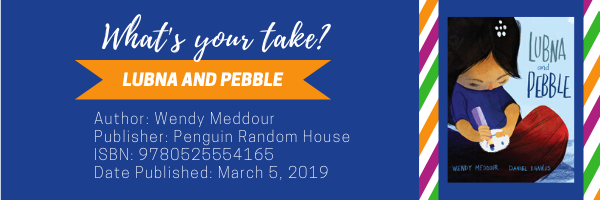Jean Schroeder, The IDEA School, Tucson, AZ and Holly Johnson, University of Cincinnati, Cincinnati, OH
HOLLY: So, after Angel Thieves and The Season of Styx Malone, I can’t help but think about other relationships that might be considered strange on the surface, but on second glance create connection and hope. Another such narrative is the picturebook, Lubna and Pebble (2019) by Wendy Meddour and illustrated by Daniel Egnéus. Lubna, a young refugee, has a friendship with a pebble. She talks to it, carries it with her and finds comfort in its presence. There are profound concepts in this book that include a sense of human connection to the earth as well as the concept of the solidity of a rock, or in this case a pebble, which is appropriate for so young a child. The earth gives us our footing. We are, after all, earthlings! Lubna finds Pebble when she and her father arrive on the beach of a new country. I think of Syrian refugees crossing from Turkey to Greece and finding themselves in “a World of Tents.” Lubna is lost in thinking about her homeland, the war, and her brothers. Pebble becomes a connection and is Lubna’s best friend. Then one day, Amir, another young refugee, arrives at the camp. Amir and Lubna become friends until the day Lubna leaves because she and her father have found a new place to live. Suddenly, Pebble’s role in Lubna’s life shifts. I cannot help but think of how some relationships are strong but only temporary, yet in that limited time and space, connections and hope still form. What did you think of Lubna and Pebble, Jean?
JEAN: Those connections can be strong too, though reconnection after separation is often not in the cards. For Lubna the concreteness and unconditional love of Pebble bring stability to her makeshift life. I am reminded of children who create an imaginary friend which is not concrete, yet fills a need. The illustrations add meaning for me. There is a sparseness to them that reflects the sparse surroundings Lubna and her Dad find themselves in and I imagine what they have left behind. The use of crayon reminds readers that this story is being told by children, not adults. And the Dad is pictured as a strong, huge man — just as Lubna sees him. Dad and Pebble give Lubna strength –- the strength to pass Pebble along to Amir. The illustration of Amir’s face as a double page spread at the end brings the plight of children in refugee situations to the forefront. I found it interesting that never once is the mother mentioned. Lubna tells Pebble about her home, the war and her brothers, but not her mother. In fact, Lubna is the only female character. I wonder if she thinks of Pebble as a girl or boy. It leaves it open for Amir to decide Pebble’s gender as he imagines. A community with flexibility.
HOLLY: This book directly shows how connections across differences creates community. The relationship between Lubna and Pebble is one of difference that creates a sense of community and connection between Lubna and Amir. They may never see each other again, but the connection still remains. And perhaps, when Amir finds a permanent home, he will bequeath Pebble to another dislocated child who needs a sense of connection—and a sense of the earth beneath their feet–in such frightening circumstances. There is something to be said about connections build upon the foundation of a rock. Perhaps it is a sense of belonging intertwined with hope.
JEAN: The earth beneath our feet is often referred to as Mother Earth. That connection for Lubna does seem strong. There is definitely a sense of belonging and hope, but I do see that ever changing community as well. I am reminded of a quote from Bud by Kevin O’Malley (2000) saying “Change is inevitable except from a vending machine.” Lubna’s community changes many times and will continue to change throughout her life, yet there will always be stabilizing forces. She may be able to share her thoughts with Pebble long after Pebble has left her hands. New people will become welcome members of her family and community and she will become a member in multiple different communities. Therein is the hope and belonging and grounding.
Title: Lubna and Pebble
Author: Wendy Meddour
ISBN: 9780525554165
Publisher: Penguin Random House
Date Published: March 05, 2019
Throughout November 2019, Jean and Holly give their take on books focused on youth taking action. Check back each Wednesday to follow the conversation!
- Themes: Holly Johnson, Jean Schroeder, Lubna and Pebble, Wendy Meddour
- Descriptors: Books & Resources, My Take/Your Take

